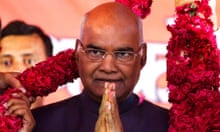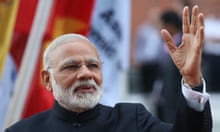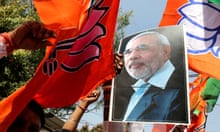Imagine a film about the Holocaust where a character pulls open a drawer, pulls out a document and reveals that 6 million deaths aren’t the fault of Hitler but of … Mussolini.
True, this isn’t a documentary. It’s a Hollywood film like James Cameron’s Titanic, in which fictional characters inhabit a crowded landscape of real people and real events, some of the most dreadful in the 20th century’s history. Sure, you have to cut the director a little slack. Reality is always more complicated than any film has the time to allow. But blaming it on Mussolini! A ripple of distaste and incomprehension crosses the audience at the thought that such a hideous chapter in European history should be so irresponsibly treated, as if it were no more than “material” to be bent to the director’s whim.
In south Asia, the partition of 70 years ago has a similar resonance to the Holocaust in the memory of the two (eventually three) nations that came out of it. Between 1 and 2 million people are thought to have died; about 15 million left their homes to cross the new borders – a great migration of Muslims to the new state of Pakistan, and Sikhs and Hindus into truncated India. Mass violence and death, startling cruelty, hunger, disease, homelessness: all these accompanied India’s liberation from British rule.
Apportioning the blame has kept scholars in work for half a century. Was it the intransigence of the Indian National Congress and/or the All-India Muslim League, and their leaders Jawaharlal Nehru and Muhammad Ali Jinnah? Was it the inevitable outcome of the imperial policy identified by its opponents as divide-and-rule? Did it flow from the politicisation of religious identity? How much of it can be put down to British haste, weakness and incompetence? How much did the characters of the last viceroy and his wife, Lord Louis and Edwina, Lady Mountbatten, play a part?
These questions underlie the plot of a new film, the historical drama Viceroy’s House, which embeds the fictional story of a love affair between a young Hindu man and a Muslim woman in the context of the last days of British rule. The year is 1947. Mountbatten has been dispatched to Delhi by Clement Attlee’s Labour government to get Britain out of India as speedily as possible, and soon decides that he needs to bring forward the date from June 1948 to August 1947, otherwise the country faces a civil war which dwindling British forces can do nothing to prevent. This gives him less than six months.
Failing to persuade the Congress and Muslim League leaders to agree on the constitution of an undivided India, he proposes a plan to divide the country roughly according to religious identity. Nehru and Jinnah accept, India and Pakistan celebrate their independence, carnage erupts.
The film takes its title from the 340-room palace designed as the viceregal residence by Edwin Lutyens and now occupied by the Indian president, forcing the film to use another almost equally grand palace in Jodhpur for its location work. There are some opulent scenes and a few nice performances, particularly Gillian Anderson as Edwina and David Hayman as the house’s Scottish major-domo. (Less successfully, Hugh Bonneville plays Mountbatten as Lord Grantham.)
Notices by film reviewers have been muted but reasonably kind – the Guardian gave it three stars. Notices by historians, or indeed anyone who cares about the events portrayed, have been damning.
In an angry piece for the Guardian, the Pakistani writer Fatima Bhutto accused the film’s British-Indian director, Gurinder Chadha, of seeming “to take pleasure in laying the bloodshed and brutality of 1947 at the feet of two particular villains: Muslims and Jinnah”. It was, she wrote, the product of “a deeply colonised imagination … [a] servile pantomime of partition”.
Chadha denied the charge of anti-Muslim prejudice – persuasively, I think – but to my mind she and her fellow writers on the film, her American husband, Paul Mayeda Berges, and the English screenwriter Moira Buffini, have committed just as great a sin, which is to take a breathtaking liberty with the historical record.
The film’s Mussolini moment occurs when the unfortunate English lawyer who has been commissioned to draw the new boundaries, the sweating, put-upon Cyril Radcliffe (Simon Callow), returns from the Punjab to Delhi to say it can’t be done in the few weeks he has at his disposal. It’s all too complicated, he tells Mountbatten’s chief of staff, Lord Ismay (Michael Gambon), who then pulls from his drawer a secret map, prepared under Winston Churchill’s aegis, which has the border already drawn. Ismay, who served as Churchill’s wartime chief of staff, suggests Pakistan was at least partly a British invention as a bulwark against the Soviet Union. Hey presto! All Radcliffe needs to do is adopt the Churchill map’s borders.
Mountbatten, from whom this information has been concealed, feels angry and betrayed when he finds out. The film’s clear implication is that when it comes to Britain’s share of the blame for the bloodshed of 1947, Churchill, not Mountbatten is the culprit.

By 1947, Churchill had been out of power for two years. Certainly, he was no friend to India – his behaviour during the Bengal famine in 1943 was notably callous – but I can find no historian who thinks this interpretation of events is anything other than a travesty. Its origins lie in a little-known book published 11 years ago by a former Indian diplomat, Narendra Singh Sarila, who was a junior member of Mountbatten’s staff.
Mountbatten’s biographer Philip Ziegler wrote in his Spectator review that the book was “interesting, if essentially wrong-headed”. Gordon Johnson, a former president of Wolfson College Cambridge, thought Sarila’s theory “just a reworking of the paranoid ‘divide-and-rule’ canard … without realistic foundation”. Anil Seal, fellow of Trinity College Cambridge, described it as a “dangerous romance” that will fuel the notion that the British were calling the shots when in fact the real political power had moved to the Congress party. Faisal Devji, reader in Indian history at the University of Oxford, wrote that its appeal lay in its denial of “any legitimacy and indeed integrity to the Pakistan movement, by attributing it entirely to British conspiracy and Muslim treachery”.
The film is unlikely to do very well at the box office. Even so, it will attract a far larger audience than any book on partition, and for many people it will be their only understanding of the subject. As with “fake news”, so with “fake history”. Detecting it needs curiosity – critical rather than passive consumption – otherwise it never gets found out.
How did Seal’s “dangerous romance” happen in this case? In the film’s credits, only one name is listed as a historical adviser: Alastair Bruce, described as a “royal commentator, Officer of Arms and a member of the Queen’s Body Guard for Scotland”. He worked previously on The King’s Speech, The Young Victoria and Downton Abbey. The clothes and manners of the English aristocracy seem to be his specialism. Chadha has said that she wanted to make “an Upstairs, Downstairs” of partition. And that – rather pointlessly – is what she has got, even down to Lord Grantham’s dresser.









